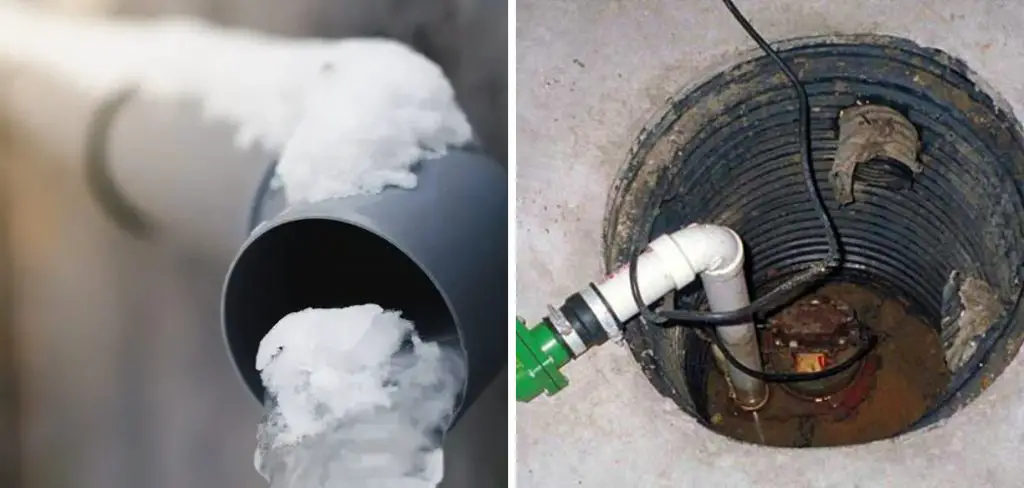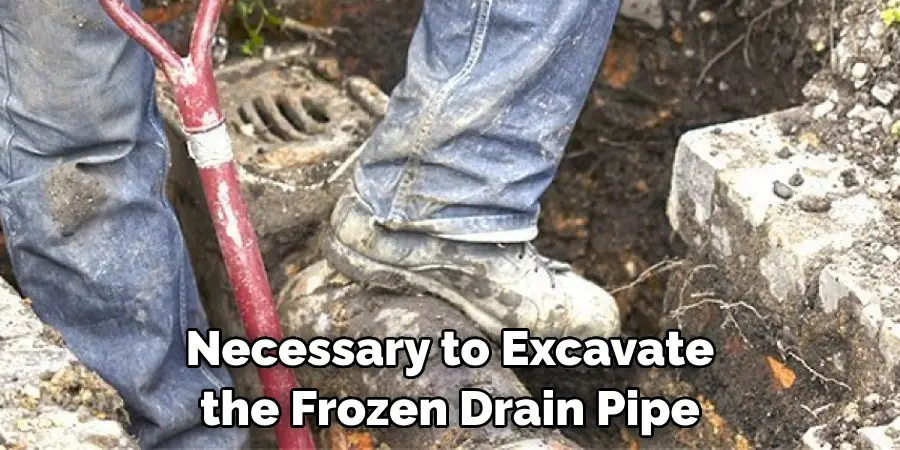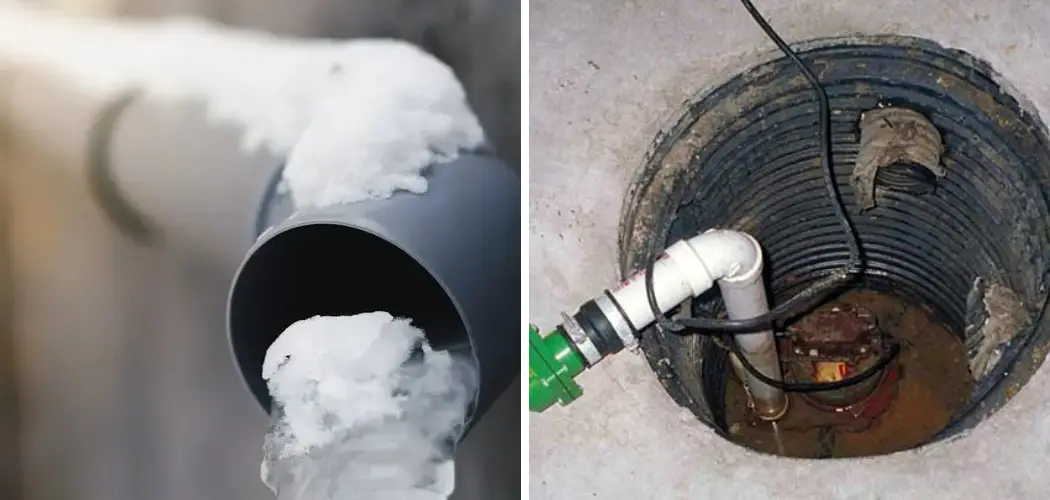Are you constantly frustrated by frozen drain pipes that have been buried underground? Has clearing the blockage become an all-too-familiar winter chore? If so, then this post is for you! In it, we’ll cover a range of tips and tricks on how to thaw frozen drain pipes underground and prevent them from freezing in the first place.

We’ll discuss various techniques from using hot water and steam to wires with electricity flowing through them. You’ll also learn about preventative measures you can take to ensure those pesky winter blockages won’t return again next year. Now, let’s dive in and get started on mastering the art of safely thawing out your underground sewer lines!
Why Do Drain Pipes Freeze?
Before we get into the nitty-gritty of thawing frozen drain pipes, let’s take a quick look at why they freeze in the first place. The main reason for this is because water expands when it freezes. This can cause trapped water to expand and put pressure on your pipes, potentially leading to cracks or bursts.
Additionally, as temperatures drop below freezing, the water in your drain pipes can solidify and create a blockage. This is especially common in underground pipes that are not insulated or properly protected from the cold.
10 Best Methods on How to Thaw Frozen Drain Pipes Underground
1. Use Boiling Water:
This is the most common and simplest method to thaw frozen pipes. Simply boil a large pot of water and carefully pour it down the drain. Make sure to use caution as you don’t want any of the boiling water splashing back at you. Using boiling water can quickly melt the ice and clear up any blockages. This method is most effective for smaller blockages that are closer to the surface.
2. Apply Heat With a Hair Dryer:
If you have access to an electrical outlet near the frozen drain pipe, using a hair dryer can also be an effective method. Start by setting your hair dryer on the lowest heat setting and pointing it towards the frozen area of the pipe. Gradually increase the heat as needed until the pipe thaws. Be careful not to overheat the pipe, as this can cause damage.
3. Thaw With Hot Towels:
For larger frozen drain pipes, using hot towels is a great option. Soak several towels in hot water and wrap them around the frozen area of the pipe. This will help transfer heat to the pipe and gradually melt the ice. Make sure to keep an eye on the towels and replace them with freshly heated ones as needed. This method may take a bit longer, but it is a safe and effective way to thaw larger pipes.

4. Use a Heat Lamp:
If you have a heat lamp available, this can also be helpful in thawing frozen drain pipes. Position the heat lamp near the frozen area of the pipe and leave it on for several hours until the ice has melted. Just like with the hair dryer, be careful not to overheat the pipe as this can cause damage. Using a heat lamp can also help prevent the pipe from refreezing.
5. Try Using Salt:
Salt is another common household item that can be used to thaw frozen pipes. Simply pour a generous amount of salt down the drain and wait for it to melt the ice. This method works best for smaller blockages, but it may take some time to fully clear the pipe. Salt also helps prevent the pipe from refreezing. This method is not recommended if you have metal pipes, as the salt can cause corrosion.
6. Use a Wet/Dry Vacuum:
If your frozen drain pipe has standing water, using a wet/dry vacuum can be an effective way to remove it and thaw the pipe at the same time. Simply place the vacuum over the drain and let it suck out any excess water. The vacuum’s heat will help thaw the ice and clear the blockage. This method is not recommended for plastic pipes, as the heat from the vacuum can cause them to melt.

7. Apply Hot Compresses:
Similar to using hot towels, applying hot compresses to the frozen area of the drain pipe can help melt the ice and clear any blockages. You can use hot water bottles, microwavable heating pads, or even a bag of rice heated in the microwave. Just be sure to wrap them in a towel before applying to prevent burns. This method may take longer, but it is a safe and effective way to thaw frozen pipes.
8. Use an Electrical Pipe Thawer:
If you frequently have issues with frozen drain pipes, investing in an electrical pipe thawer may be worth considering. This tool uses high-frequency electrical current to heat the pipe and melt any ice within it. It’s important to follow the instructions carefully and use caution when using this method, as some pipes may not be able to handle the high heat. Using an electrical pipe thawer also requires some technical knowledge, so it may be best to hire a professional for this method.
9. Thaw With a Pipe Heater Cable:
Pipe heater cables are another tool that can be used to prevent and thaw frozen drain pipes underground. These cables wrap around the pipe and use heat to melt the ice and keep the water flowing. They are easy to install and can be left on during the winter months to prevent any future blockages. Just be sure to follow the manufacturer’s instructions and use caution when handling electrical equipment.

10. Hire a Professional:
If none of the above methods work or you don’t feel comfortable trying them on your own, it may be best to hire a professional plumber. They have the knowledge and equipment to safely thaw frozen drain pipes underground without causing any damage. They can also inspect your pipes and provide recommendations for preventing future blockages.
Following these methods and taking preventative measures can help you safely thaw frozen drain pipes underground. Remember to always use caution when handling hot or electrical equipment, and if the problem persists, don’t hesitate to call a professional for assistance.
With proper maintenance, you can keep your underground sewer lines clear and avoid any costly repairs in the future. So get out there and confidently tackle those frozen drain pipes! Happy thawing!
Additional Tips and Tricks to Thaw Frozen Drain Pipes Underground
- If you have access to a heat source, such as a portable heater or hair dryer, you can use that to thaw the frozen drain pipe. Simply direct the heat towards the location where the pipe is frozen and wait for it to defrost. Be careful not to overheat the area, as this could cause damage.
- Another option is to pour hot water down the drain pipe. The hot water will help melt the ice and allow the water to flow again. However, be cautious when using this method, as pouring too much hot water at once could cause the frozen pipe to burst.
- You can also use a plumbing snake or auger to break up any ice clogs in the drain pipe. These tools can be inserted into the drain pipe and rotated to break up the ice, allowing water to flow freely again.
- If you have access to a wet/dry vacuum, you can use this to remove any standing water in the drain pipe. This will help clear out any excess ice and allow for easier thawing.
- In some cases, it may be necessary to excavate the frozen drain pipe in order to thaw it. This should be done by a professional plumber, as it can be a delicate and potentially dangerous task.
- To prevent future frozen drain pipes, make sure to properly insulate any exposed pipes and keep them warm during cold weather. You can also use heat tape or heated cables to provide additional protection against freezing.
- Regularly flushing your drain pipes with hot water can also help prevent ice buildup and keep them flowing smoothly.
- If you have a septic system, make sure to regularly pump it to prevent frozen drain lines due to excessive sludge buildup.
- Lastly, be aware of any potential warning signs of frozen drain pipes, such as slow draining or gurgling noises from your pipes. Addressing these issues early on can help prevent major problems in the future.

With these additional tips and tricks, you should be able to effectively thaw frozen drain pipes underground and prevent them from becoming a recurring issue. Remember to always exercise caution when dealing with frozen pipes and seek professional help if needed. Happy thawing!
Things You Should Consider to Thaw Frozen Drain Pipes Underground
1. Identify the Frozen Drain Pipes:
Before you start thawing your frozen drain pipes, it’s important to know which pipe is actually frozen. This will help you understand the length and location of the problem, making it easier for you to come up with a solution. Identifying the frozen drain pipes also ensures that you don’t waste time and effort thawing pipes that are not actually frozen.
2. Use Warm Water:
One of the most common ways to thaw frozen drain pipes underground is by using warm water. Fill a bucket with hot water and pour it down the drain pipes. This will help in melting the ice that has formed inside the pipes and allow the water to flow freely again. However, make sure that you don’t use boiling water as it can damage the pipes.

3. Heat the Pipes:
If using warm water doesn’t work, you can try heating up the frozen drain pipes. You can use a hairdryer, heat gun, or portable heater to warm up the pipes. Hold the heat source close to the pipe and move it around until you feel that the ice has melted enough for the water to flow again. Be cautious when using this method as excessive heat can damage the pipes.
4. Use Salt and Hot Water:
Salt is known to lower the freezing point of water, which makes it a useful tool in thawing frozen drain pipes. Mix a cup of salt with hot water and pour it down the drain pipes. The salt will start melting the ice inside the pipes and help in unclogging them. This method may take a while to work, so be patient.
5. Try Commercial Drain Thawing Products:
If none of the above methods seem to work, you can try using commercial drain thawing products that are specifically designed for this purpose. These products have powerful chemicals that melt the ice inside the pipes and unclog them. However, make sure to read the instructions carefully before using these products as they can be harmful if not used correctly.

6. Prevent Future Freezing:
To avoid facing this problem again in the future, it’s important to take preventive measures. Insulate your drain pipes with foam or heat tape to protect them from freezing temperatures. Also, make sure to regularly clean your drain pipes to prevent any buildup of debris or ice. This will help in maintaining proper drainage and prevent future blockages.
By following these considerations, you can successfully thaw frozen drain pipes underground and prevent any further problems. Remember to always prioritize safety and take caution when dealing with frozen pipes. So, keep these tips in mind, and don’t let a frozen drain pipe ruin your day!
Conclusion
Now you know how to thaw frozen drain pipes underground and the ways in which you can prevent them from freezing in the first place. By understanding the causes of frozen pipes and implementing preventive measures, you can save yourself from a lot of hassle and costly repairs.
Remember to always check for potential issues with your drain pipes before the winter season starts, such as uninspired insulated pipes or cracks that may allow cold air to enter. Taking these simple steps can go a long way in preventing frozen drain pipes.

